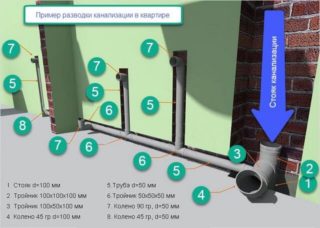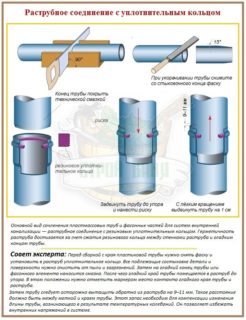It is impossible to equip a sewer line without pipes with a diameter of 50 mm. But for proper installation, you need to choose a high-quality building material. To do this, you need to know the technical characteristics of 50 mm products and the rules for connecting to plumbing fixtures.
Application area
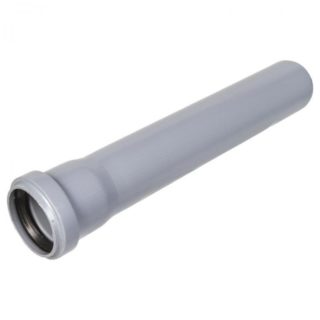
Pipes d50 are used for the cultivation of internal sewerage and the reconstruction of old pipelines in houses, the height of which does not exceed 10 meters.
Products are also used in other industries:
- supply and drainage of water in pools and fountains;
- transportation of drinks in food production;
- supply of water to irrigation devices and drinkers for livestock and poultry.
Pipe sections made of resistant materials are used to remove gases and liquids containing corrosive substances in chemical industries. Heat-resistant models are used to equip heating systems.
Products with a cross section of 50 mm are not used for external sewer lines, therefore, they are not released in their characteristic red color. The standard shades of these pipes are gray or white.
Design characteristics and connection features
The traditional length of 50 mm products is from half a meter to 8 meters.
The models are distinguished by a smooth inner surface, although flexible corrugated versions are also produced. They are used in areas of the system where it is difficult to establish a standard design. The accordion pipe is able to take the desired configuration, being placed in the narrowest and smallest bathroom.
Pipe sections are most often connected with a socket method, their length usually does not exceed 3 m. Products are also produced without sockets. For their articulation, shaped elements of a similar section are needed.
With the help of pipes of 50 mm, water is diverted from the following plumbing fixtures:
- bath and shower;
- kitchen sink;
- bidet and washbasin.
Pipes are also used for combined drains and further internal wiring. For risers and connecting a toilet bowl, pipe sections of a larger section are used, usually 110 mm.
In addition to standard products, silent versions are also produced. Noise insulation occurs due to the inclusion of minerals in the composition of the material, increasing the molecular weight, and increasing the thickness of the walls. Products are most often white, but they are also gray or with green and red stripes on a light background. When choosing, do not be guided by color alone. Check the labeling - good pipes always indicate the brand and the amount of noise reduction in decibels.
To reduce the noise of standard products, when fastening, a system of clamps is used, which removes the lines from the walls and reduces vibration. Additionally, the pipes are enclosed in polystyrene cases or sound-absorbing boxes.
Manufacturing materials
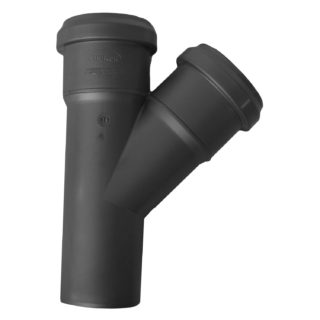
Pipe lengths of 50 mm are made from various polymers, as well as from cast iron or steel - galvanized and stainless. Each material has its own advantages and disadvantages, but at home, lightweight and low-cost plastic pipelines are usually installed.
Polymer products
Plastic sewer pipe (polyvinyl chloride, polypropylene, polyethylene) with a diameter of 50 mm is most often used in modern drainage networks.
Budgetary, and therefore the most popular option is PVC pipes. It is easy to assemble a new highway from them and reconstruct the old one. Thanks to modern fittings, it is easy to connect the plastic pieces to the cast iron outlets. Price per running meter of PVC sewer pipe with a diameter of 50 mm - from 19 rubles.
The positive characteristics of polyvinyl chloride, in addition to low cost and low weight:
- resistant to acids and alkalis, ultraviolet;
- quite dense (1.35 to 1.43 grams per cubic centimeter);
- is a dielectric.
Disadvantages are considered to be low impact resistance and fear of high temperatures: the liquid should not be hotter than 65 degrees. PVC products do not differ in flexibility; for even small turns, you will need to use specialized fittings, otherwise the pipe will simply crack.
Polyethylene pipes have the smoothest possible inner surface, which increases flow capacity and reduces the risk of clogging.
Products are not afraid of low temperatures and aggressive reagents, but they can deform under the influence of hot liquid (above 80 degrees). When used in the sewage system, the latter drawback does not matter, but if it is supposed to install pipes for the heating network, products made of cross-linked polyethylene are required. Their resistance to hot water is much higher.
Polypropylene pipes are abrasive resistant, withstand temperatures up to 140 degrees. Such lines are easier to clean from blockages, since they are not afraid of chemicals, even concentrated acids. The density of polypropylene is 0.91 grams per cubic centimeter, which makes the pipe lengths very light and easy to assemble.
Polyethylene and polypropylene lines are more durable than PVC products, they suffer less from vibration and linear expansion. However, pipes are more expensive than polyvinyl chloride models: the cost of polypropylene products starts from 50 rubles, and polyethylene products - from 75 rubles per running meter.
Metal pipes
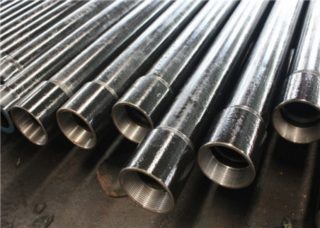
Internal sewer pipelines are made of galvanized steel, stainless steel and cast iron.
Steel products are durable, they are not afraid of cold, heat, acids or alkalis, they are not subject to linear expansion, but they weigh quite a lot. Conventional galvanized steel alloys sooner or later become rusty. Stainless steel pipelines are devoid of this drawback, but due to the high price (from 350 rubles per kg), products are rarely used for domestic sewage systems. The scope of their application is the oil, food and perfumery industries.
Cast iron pipes have many advantages, of which the main ones are:
- high strength;
- durability (able to last up to 100 years);
- low susceptibility to corrosion;
- budgetary cost (from 15 rubles per kg).
Over time, the inner surface becomes rough, resulting in build-up and frequent blockages. Installation is complicated by the large weight of pipe sections - a meter of cast iron pipeline with a cross section of 50 mm weighs 7 kg, and a polymer product of similar dimensions is less than a kilogram. Because of this, 50 mm cast iron lines are practically not used for internal sewer pipelines.
Installation features
If the pipe sections are not equipped with sockets, they are connected using fittings. The edges of the pipes are also degreased, sanded with sandpaper and sealed with a sealant.
For the assembly of polyvinyl chloride lines, an adhesive joint is also used, and for products made of polypropylene and polyethylene, the method of thermal welding. In the latter case, you will need a special tool - a soldering iron with nozzles. The formed connection is one-piece, the pipes will have to be cut when dismantling.
No matter how the assembly of the line from 50 mm pipes is carried out, a slope of 0.03 degrees or 3 cm per meter is required. This can only be dispensed with if pumping equipment is installed.
When choosing 50 mm pipes, consider their technical characteristics, depending on the purpose. If you purchased the material during the project phase, store the pipe sections only in a horizontal position so that they do not bend.

